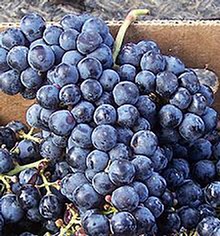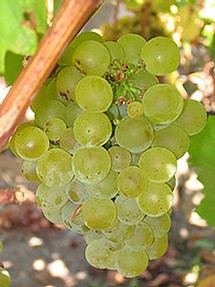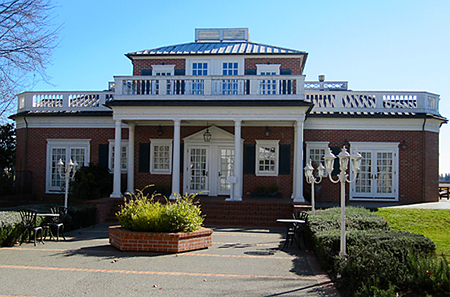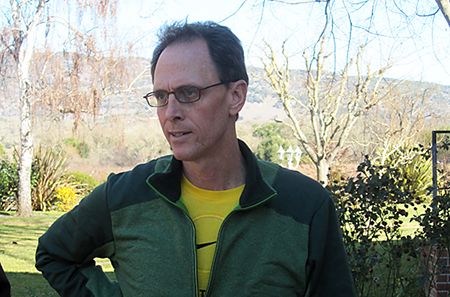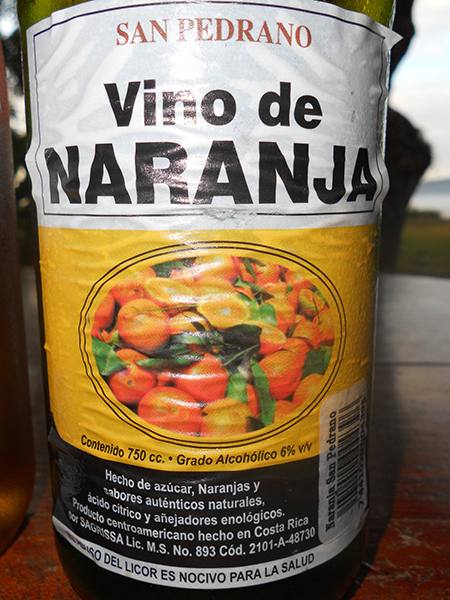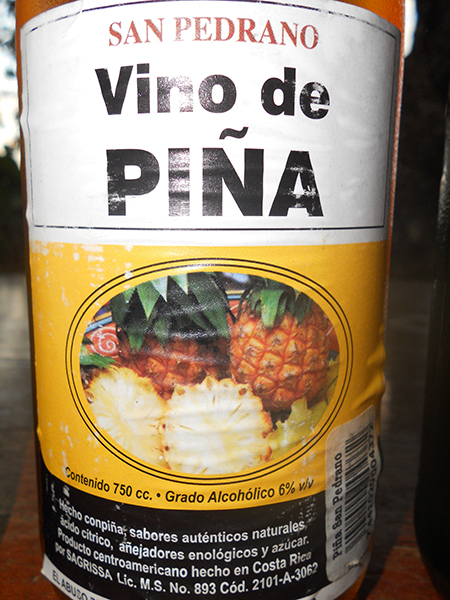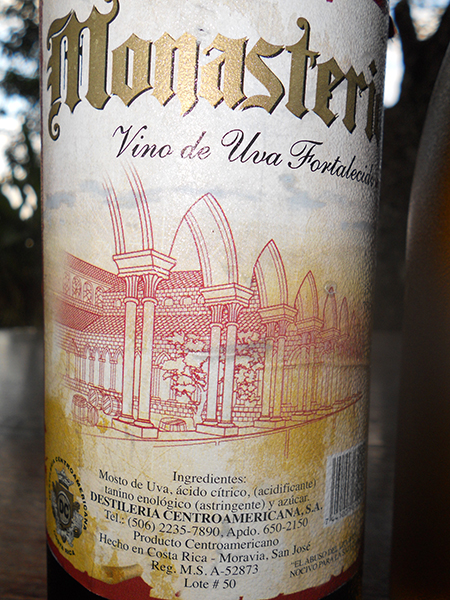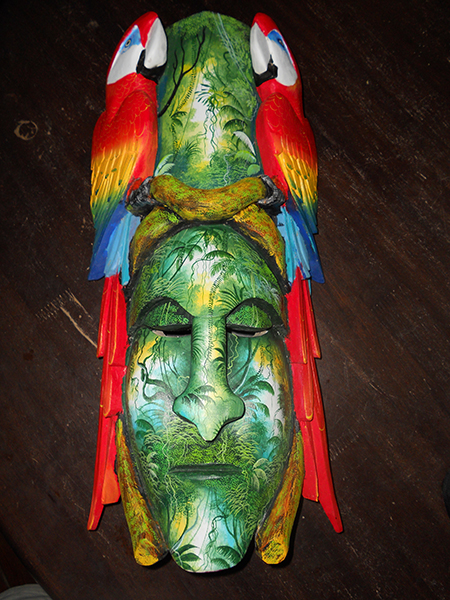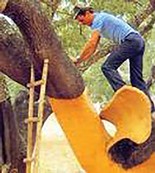The Single Most Important Thing About Tasting Wine
All of our enthusiastic fans and supporters of our MONTICELLO and CORLEY wines intuitively understand the single most important thing about tasting and enjoying wine.
They know what they like, and what they don't like. Everything beyond that first intuitive questions is just a variation of 'Why?'
Most everyone can quickly and intuitively determine whether or not they like music when they hear it. Many of those same people don't have a deep understanding of musical theory, or whether the song is composed in 4/4 or 7/8 time, or if the primary chords are minor or major, or if it's being played in the key of E, A or C. They just feel, they know if they like it or not.
In an instant, you'll know whether the music of bagpipes is inspiring to you and makes you want to don a kilt, paint your face and charge down a mountainside into battle ... or its a wail that makes you want to run and hide in a highland cave. The first question is answered intuitively ... Do I like it or not? How does it make me feel? ... You don't need to understand how the bagpipes work, when or why they were invented or how they are used in battle or ceremony.
You'll know intuitively whether or not the sounds of distorted heavy metal guitar, conga drums, mandolins or pan flutes appeal to you without understanding anything about the instruments or how they are played. You'll know whether you prefer the rhythm of Metallica or Mozart, without needing to understand the technical complexities of the compositions.
It's the same with wine. You'll know intuitively whether or not you like a wine when you first taste it. You don't need to understand the dynamics of yeast fermentation, the soil composition of a vineyard block, or whether the wine was aged in French oak for 22 months or 28 months to determine if you like the wine. That information answers the questions 'why?'.
Do I like it? How does it make me feel? This is intuitive, primary, tangible and visceral. Deeper levels of understanding can generate deeper levels of enjoyment ... enhanced, enlightened and intellectual ... they come from all of the secondary and teritary 'whys?'.
On a primary level, every one of us is qualified to answer the visceral questions ... Do I like it? How does it make me feel?
We hope that you enjoy our MONTICELLO and CORLEY wines, and that we'll have opportunities to help you answer the 'Whys?'
A Grape Liaison of Promiscuous and Forbidden Fruits
"Posted By : Chris Corley
Can we be enlightened on interpersonal relationships and social mores by a promiscuous 17th century grape? I propose that we can. Some time ago, perhaps in the late 1600s, probably in the southwest of France, and maybe under the light veil of a moonlit night, a dark-skinned grape called Cabernet Franc had an intimate liaison with a fair-skinned grape by the name of Sauvignon Blanc.
CABERNET FRANC
A relationship of this nature likely would be frowned upon at that time by many, so this was a daring rendezvous for these two grapes. Cabernet Franc was bold, masculine and well-endowed with a spicy demeanor. Sauvignon Blanc was alluring, feminine and tantalizingly fragrant. How could they resist one another? They couldn't. The offspring of that romantic intermingling was called Cabernet Sauvignon, certainly a personality that we are all familiar with here in the Napa Valley.
SAUVIGNON BLANC
Today, I am enjoying a glass of our newly released 2010 Estate Grown Cabernet Franc, and as I revel in its dark, spicy fruit, bold texture and long finish, I am thinking to myself ... Has Cabernet Franc tamed his libidinous ways? Should I be worried about our own Cabernet Franc that is planted right next to our Chardonnay in Block 4? What romantic adventures are going on in our vineyard when the afternoon breeze picks up, the sun begins to fade into the Mayacamas, and the shoots and tendrils begin to intertwine? Ahh, too much to think about ... I'll have another glass of Monticello 2010 Estate Grown Cabernet Franc! "
Monticello Vineyards experiments with wine flavored cheese
"Guest Blog : Posted on January 26, 2012 by Ray
This is a guest blog post by Vintage Wine Taster and good friend Ray Conti. Ray and his wife recently took a trip to the Monticello winery on Big Ranch Road in the Napa Valley. They escorted two friends who own a dairy near Santa Fe, New Mexico.
Their two Santa Fe friends, Ed & Michael Lobaugh, own The Old Windmill Dairy® just outside of Santa Fe, New Mexico. They make a wonderful variety of artisan goat and cow cheeses. At a Wine & Cheese festival in Carlsbad, Monticello Vineyard's Stephen Corley approached them and indicated the winery might be interested in combining the Monticello wines with their Gouda cheeses. Monticello sent a case of their wines containing three varietals: Estate grown Chardonnay, Pinot Noir, and Cabernet Sauvignon.
About Monticello Winery
Monticello is a small winery by Napa standards (15,000 cases), but their quality makes up for the small quantity. Jay Corley founded the winery in 1970 and today sons Kevin, Stephen and Chris Corey are operating the winery. Kevin oversees the operation, Stephen is in charge of sales, and Chris is the winemaker. The winery lies just above the town of Napa. It is on Big Ranch Road that can be accessed from Oak Knoll Road. They have three lines of wine: Corley Reserve, Corley Family wines, and Monticello Reserve wines. Their specialties are Cabernet, Pinot Noir, Merlot and Chardonnay. The friendly tasting room is opposite a 1/3 scale replica of Jefferson's Monticello; a tribute to America's first serious wine collector. This is a fun place to start a wine tour of the Napa Valley
About the Cheese Project
This is the process used to infuse the Monticello wines into the Gouda cheese. After the initial stages to develop the curd from the cow's milk, the mixture is pressed into wheels. After 12 hours the cheese hardens sufficiently it is removed from wheels and is transferred to a vat brine mixture of wine, salt and purified softened water. After several days the cheese is then removed and dried on a rack at room temperature. All these steps are done by hand and the length of time is determined by how the cheese feels to the touch and how it tastes and smells. Once the cheese develops an oily dark surface, it is hand waxed with a clear wax and than a dark red wax. After the wax is dry, the cheese is transferred to an underground cellar and aged at a temperature of 54 degrees Fahrenheit. The Monticello cheeses were aged for 60 days. The flavor results in a moister, creamier yet mild flavored Gouda. When aged for approximately 5 months, the cheese will develop a more robust flavor. Each of the Monticello wines will create a very different flavor in the Gouda cheese.
This is an ongoing project with much experimentation to get the perfect wine-flavored Gouda cheese. Ed & Michael Lobaugh are eagerly waiting to see what the Corley family thinks of this young batch of Gouda. The hope is that the project will result in cheeses the Corely family will want to feature in their tasting room and possibly sell to Napa Valley restaurants. We will be sure to get back to you when the results are in and indeed if this Gouda is available for sale.
"
Costa Rica : Fruit Wine & Indian Masks
Posted By : Chris Corley
We're currently in Costa Rica and have enjoyed a nice week in Playa Pochote, which is considered a town here, but really is more like 100 or so locals that live near each other and a campground where the 'ticos' from San Jose come to beach camp for the weekend. The local services in ""town"" include a payphone.
I had zero expectation of finding any local wines in Costa Rica, so didn't even think much about it. I was ready to spend my time guzzling Imperial lagers in the sun and looking forward to the fresh fish. To my surprise, when we went to the little village market in the next 'town' called Tambor, the fellow in the store directed towards the the surprisingly well stocked wine aisle, where I found several Costa Rican wines.
It struck me at that moment, that my subliminal notion of wine automatically referenced my own experiences, that is grape wine. There were actually shelves full of all sorts of local wines - fruit wines - pineapple, orange, and grapes too. My interest in traveling is in tasting the local efforts. I didn't come all this way to drink and eat things I can get at home. So I loaded up a few bottles of the local wines and headed home, excited to taste these wines.
Please keep in mind, I'm a winemaker, not a critic nor a winewriter. I'll just stick to describing rather than critiquing. At these wineries in Costa Rica, no doubt there are a group of people of that are trying to do the best they can with what they've got, and I have no interest in disparaging their or anybodys efforts, regardless of the results.
SAN PEDRANO 'VINO DE NARANJA' - I'm not really sure what I was expecting before tasting wine made from oranges, but I was a little surprised when I poured it in the glass and it looked like a slightly oxidized white wine. The aromas were not nearly as strong orange as I anticipated. The wine was pleasant on the palate, with a nice acidity, basically dry (no residual sugar), and was not as strong in orange flavor as I thought it would be. This wine would be a good match for a bowl of fresh ceviche on the beach, and I wouldn't be surprised if thats the way its most commonly consumed.
SAN PEDRANO 'VINO DE PINA' - This wine was the most enjoyable for just sipping on by itself. The aromas and flavors of pineapple were much stronger than in the orange wine. The nature of the pineapple tones kind of lent themselves to a refreshing tropical drink. The texture, just like the orange wine, was more similar to grape white wine than I was expecting. The wine was visually clean as though it had been filtered, or at least fined very well. The texture was not viscous or syrupy at all, like pineapple juice can be. Chilled, this was my favorite of the three.
MONASTERI 'VINO DE UVA' - This wine was interesting to taste. Its the one wine we found that was actually made from grapes. It was difficult to discern any particular fruit flavor from the wine. The acidity was a little tart and out of balance, likely due to the citric acid addition mentioned in the ingredients. This was somewhat balanced by the residual sugar. This wine was interesting to taste and I think would be best served chilled and with some really spicy food.
On a completely unrelated-to-wine note, I've got take a moment to talk about some artwork that we came across here in Costa Rica. My wife, Julianna, and I have for years enjoyed collecting masks. We try to collect one at every destination, whether its an old Indian ceremonial mask at the pueblo in Taos, a cloth spiritual mask in Peru, or a simple wooden mask from Isla Roatan. They're great personal reminders of shared adventures, and if chosen well, can be very reflective of the culture. We've got a growing wall full of them in our dining room at home.
That said, in Costa Rica, we've come across some of the most ornate masks yet. They are made by the Boruca Indian tribe, an indigenous people of Costa Rica. They are carved of balsa wood, so are soft and light. The carving is very impressive, but the intricacy and vibrancy of the painting is extraordinary. The masks are carved and painted so vividly to represent the devil and originally were utilized to scare off the invading Spanish conquistadors. These are the most colorful and vibrant masks we have personally come across, and its reassuring knowing that some of the proceeds from the sales of the mask go back to help fund the preservation of the Boruca Indian culture, which there are only about 2000-2500 living Borucan Indian tribemembers on the reserve. The tribe hosts a festival around New Years, the 'Danza de los Diablitos', reenacting the war between the indians and the conquistadors. The indians win ...
My Piano is a Babel Fish
Posted By : Chris Corley
We spend a lot of time talking about wine in our family. We talk about how certain wines taste, how they tasted in the past, how they’ll taste in the future, what foods they taste best with. Wine runs through our blood to the point that my son, Jackson, wrote the following Mothers Day note to my wife, Julianna, in his first grade class – “Happy Mothers Day. My mom is soft like a dog and ruff like a lion. Thank you for makin good wine …”. I wonder what his first grade teacher thought of his poem when he turned that in.
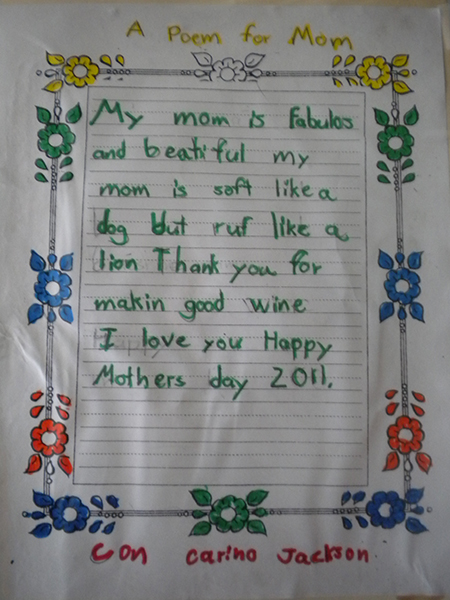
In talking about wine, we use a pretty diverse vocabulary. We speak of wines in every metaphorical means imaginable. We refer to wines in terms of colors – ‘black, blue, purple, red, golden’. We speak of wines in terms of textures – ‘smooth, rough, rich, grippy’. We converse about wines in terms of weight – ‘fat, thin, heavy, light’. We debate wines in terms of numbers – ’96, 91, 89, 92′. We revel in wines in terms of sensuality – ‘elegant, sexy, voluptuous, alluring’.
In every instance we use language to convey the message. We discuss, with words, the emotions or feelings that the wine has invigorated within us. Most of us in the professional wine tasting world understand each other when we’re in the midst of a winespeak tasting session. I imagine that it might sound like a load of gibberish to someone who is not immersed in this metaphorical world of winejaw.
When I’m presenting wines to visitors at Monticello, one of the first things I try to glean is their understanding of wine and more directly, at what level do they engage in winespeak. We don’t have a babel fish to put in our customers ears to translate my enological ramblings, so it’s important to communicate in language that everyone feels comfortable with. Note : A babel fish is a small fish that when placed in the ear will translate any language in the galaxy for the listener (from ‘The Hitchhikers Guide to the Galaxy).
Today we are hosting our Spring Release party, and will be releasing our 2008 Corley Proprietary Red Wine. The festivities will include a wine component / blending presentation that will be largely conveyed via my piano (my babel fish). I’ve deconstructed a song I wrote on the piano and matched the three main preliminary components of our 2009 Proprietary Red Wine to three main components of the song – the bass line, the melody, and the chorus. We’ll taste each of the wines while listening to the musical component. We’ll taste the blend while listening to the song as a whole. The goal is to convey one art form by using another, to minimize the words and revel in the emotion of the blend. Most everyone can feel music. You don’t need to have perfect pitch or be able to snap your fingers to a complex 7/8 rhythm. Most of us can tell when a note is out of tune, or a basic rhythm skipped. Music is a wonderful means of communication. Its inside of all of us.
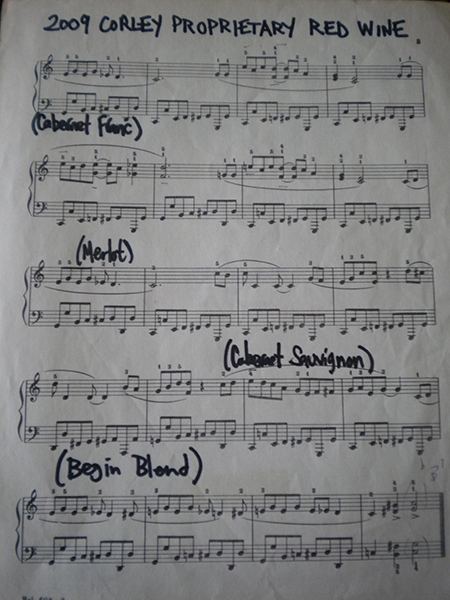
A Babel Fish Composition
Today, I want to share that visceral pleasure that I enjoy when blending our Monticello wines. At the blending table, I like to close my eyes and savor the wine, to instinctively feel and experience its pleasures or faults. I like to clear my mind of titratable acidities and tannins, and focus on the ethereal and sublime that can be found in the glass. The intellectual aspect of winemaking is done before and after the blending table. The blending table is where art is created, where the paint wets the canvas, the pen hits the paper, and the fingers strike the keys. I’d like our wine club members to experience this today. And I’d like to share it today through music
Pulling the plug on a wine in Brooklyn
"We were in Brooklyn a few weeks ago visiting our wine broker and spending a few days with my wife Julianna's sister, Joy, and her husband, Noureddine. Depending what airline we fly, we either check our wine (Southwest - bags fly free) or we send it ahead (all others). This time, we shipped several cases ahead (it cost the same to ship as it would to check, so may as well let the shipper lug it around!). It's nice to have wine ready for you upon arrival, and we were looking forward to some great bottles during our trip. Approximately a third of the wines we took to taste with our broker, but we also had plenty of nice wines for drinking, including plenty from other producers (we don't just drink our own stuff all the time!)
On our first night there, I was craving a big fat glass of red wine after a long day of family travel, and was almost salivating on the way from the airport, just thinking about popping a cork. We pulled out our first wine, and to my great disappointment, the wine was corked. It wasn't terrible, but it definitely had that familiar wet cardboard, aquarium gravel kind of smell that I just can't get out of my head once I smell it.
Cork taint is a topic that we as an industry pay close attention to. It can arise from the combination of wood product, moisture and chlorine. The offending molecule that raises the stink is called trichloroanisole (TCA). A lot of corks (wood) used to be sanitized (moisture) in chlorine based washes (chlorine), an malevolant olfactory trifecta. A winery could have a systemic problem with TCA. Many older wineries were stick-built (wood), are humidified (moisture) and historically used chlorinated tri-sodium phosphate (chlorine) as a sanitizer. Most wineries and cork producers have moved on from chlorine to other forms of sanitizers. We stopped using chlorine-based cleaners years ago, and keep our cellar relatively dry to avoid having too much moisture creating mold in our cellar.
Back in Brooklyn, we had plenty of other bottles to open, so we did, and we moved on, but it kept bugging me, and we had a fair bit of conversation about the corked bottle. I remembered reading something somewhere about using cling wrap to help remove the cork taint from an afflicted wine. I'd never tried it, but why not? It was the perfect opportunity, we'd be tossing the wine out otherwise. We wadded up a ball of cling wrap and tossed it into the decanter and swirled it around and let it soak for a few minutes, then fished it out. Interestingly, our anecdotal conclusion was that it did seem to have an impact on reducing the impact of the TCA in the wine. Not a major difference, but something noticeable and positive, and what harm is done? You've got a bottle that you've put aside anyway due to the TCA, you may as well play around with it. I'll add that this 'highly scientific' test was conducted while drinking a fair amount of other wines. While traveling, we try to complement all of our activities with copious amounts of wine, including our 'scientific' tests on the road!
Cork taint is a big topic in the wine biz, and I'm just keeping it light and anecdotal this evening on The Corley Blog. For the curious, you can read a little more about TCA at http://en.wikipedia.org/wiki/Cork_taint ."
Jamaica : Red Red Wine
Posted By : Chris Corley
A wonderful aspect of wine is its seemingly endless variety. Wine is produced in all the major regions of the world, many of which produce wines with distinctive characteristics that over time can be consistently aligned with that areas. In general, when we talk about ˜wine', we're really talking about wine made from grapes, but there are lots of wines made from other fruits as well. I've been consulting the past year on a potential project that would produce pomegranate wine.
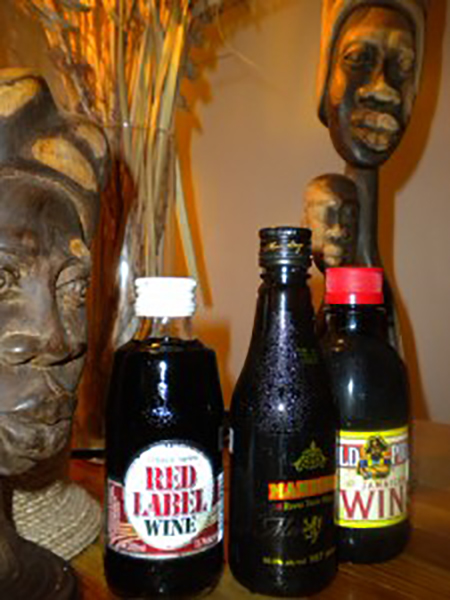
My wife and I are having an early celebration of our 10th anniversary, which is next month. We're spending a week in Jamaica, and as can be expected are enjoying all of the wonderful bounties of the island ¦ rum, snapper, conch, jerk chicken and herbs, rum.
Interestingly, when we visited a little shop in Negril to pick up a few things, I noticed about 4-5 different Jamaican wines available on the shelf. All of them were very inexpensive, a couple of bucks a bottle, and the fruit they were made from was not identified. Sugar Dandy, our sometimes ride, said that he had homemade a batch of wine from sea grapes that worked out alright for him. I don't know if these wines were made from sea grapes or not, but they definitely had some added flavors mixed in.
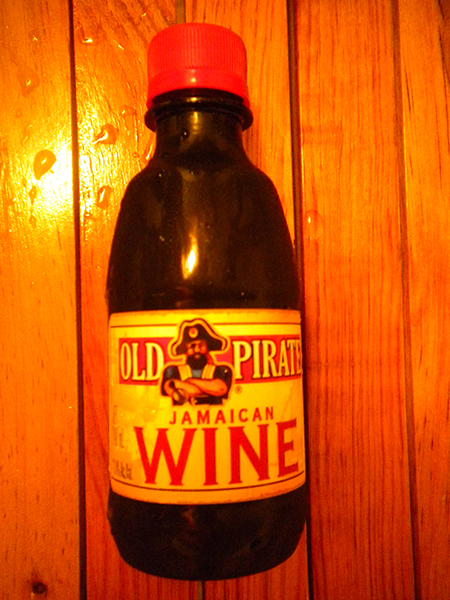
Admittedly, I didn't go to too much trouble to seek out any particular wines or even do much homework on them ¦ I'm on vacation and the Red Stripe and Rum Punch has been sufficing my needs for libation. It was fun to grab a few small bottles of what seemed to be the most popular brands in the store to get a sense of the local taste. I'm a winemaker, not a critic, so out of respect for my fellow craftsmen, I will stick to describing the wines and withhold judgment when writing on our family blog.
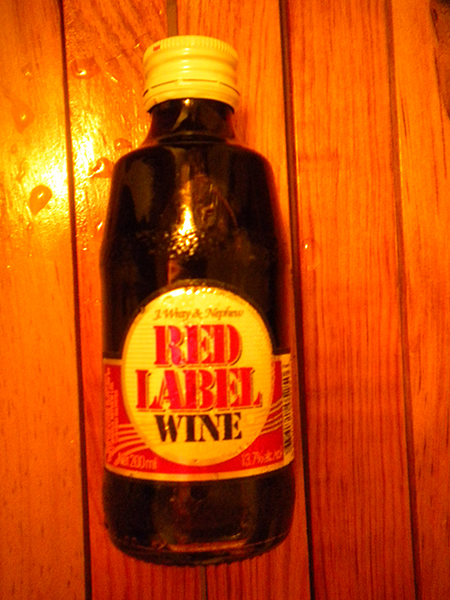
All of the wines were sweet and had very basic fruit flavors like cherry, strawberry and cola. The ‘Red Label’ wine was the sweetest and fruitiest, very viscous and almost syrupy in texture. The ‘Mandingo’ was listed as roots tonic wine, and it had a gingery kind of floral aroma and a sweet-tart bite. The “Old Pirate” was candied fruit on the nose and real easy-going on the palate, not supersweet nor acidic. The sweetness in these wines is almost port-like, it seems as though the local taste is for very sweet wines, with strong berry flavors. No right or wrong tastes, just fun for us to get a taste of the local flavors!
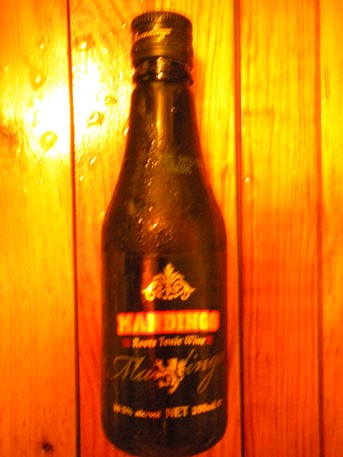
Pairing Wines
Posted By : Chris Corley
There are lots of ways to pair wines. Most wine drinkers are familiar with matching up wines with different foods. Matching up a rich Cabernet Sauvignon with juicy grilled ribeye, a crisp Sauvignon Blanc with some Thai food, or even enjoying a glass of sparkling wine with a morning brunch are all pleasures for the palate and the soul. Over the last few years, there have been magazines that have promoted the idea of pairing wine with music and websites that pair wine with art. On the surface, these may seem like gimmicky ideas, but I say ‘Why not?’. Food, music, art, conversation all appeal to our senses and if a bottle of wine enhances that experience, then its a good match in my book.
We enjoyed the fireworks show on Shelter Island, NY over the 4th of July holiday with family and friends. We laid out blankets on the beach and got all the kids organized with snacks and drinks. We opened up a bottle of 2000 CORLEY RESERVE Cabernet Sauvignon to pair with the opening fireworks. The wine started off slowly, but after it opened up a bit in the glass it exploded with bright aromas and flavors. The tannins were smooth and dusty and there was a hint of gunpowder on the finish. The wine was a nice complementary match with the show. We also had a bottle of 1999 MONTICELLO Jefferson Cuvee Cabernet Sauvignon as we dug our toes into the warm night sand for the big finale. This wine is tasting fantastic right now, after 10 years in the bottle, probably the best its ever been. From head to sandy toe, the wine was warm and rich, smooth in texture, exciting in flavor and had a great finish to go with the fireworks finale.
I ordered a glass of Long Island wine every chance I got and was pleased with the quality of the white wines in the region. There were some very nice renditions of Chardonnays, Viogniers, and Sauvignon Blancs. Given the humid heat and the propensity for summer rain, I can imagine that growing winegrapes could be a little challenging in that area, but I enjoyed most every wine I tried. Over the course of the week, we enjoyed New England clam chowders at every opportunity. One of our restaurant favorites was at Claudio’s in Greenport. On our last day, we were treated to a homemade chowder with herbs from the house garden and freshly dug clams. This chowder eclipsed all that came before it, and it was doubly enjoyable because we knew that the clams had just been dug up by our friends. We pulled out a bottle of 2005 CORLEY RESERVE Chardonnay, and it was a perfect fit. Rich, lush textures with a streak of acidity and long creamy finish. Man, I could live on that wine and chowder.
Throughout the week we enjoyed fresh caught crabs with various wines, which was a real treat for my wife, Julianna. Julianna grew up in southern Maryland and spreading fresh caught crabs out on a newspaper covered table for an afternoon of crab-cracking, cold drinks and conversation is one of her great life pleasures. I thought she was going to shed a tear when our daughter Ruby showed great interest in learning how to crack the crabs!
Of all the wine pairings we shared over the course of our trip to New York, I think the most important, meaningful and lasting were the wines we had while spending time with our family and friends there. We owe a special thanks to Joy and ‘Uncle Oredine’, Gil, Kerry, Fisher, Miles and ‘Uncle Matt’ and everyone else we were fortunate enough to spend time with back on Shelter Island and in NYC. We’ll raise a glass to all of you tonight. Another great wine pairing with all of you in our thoughts.
- See more at: http://www.corleyfamilynapavalley.com/blog/category/about-us/page/2/#sthash.lu6BYaFD.dpuf
Tasting Highlights : 2006 Big Reds
"
Posted By : Chris Corley
It's nice being on the backside of harvest. After more than my share of burritos, beer, sticky grapes, and long nights, I welcome being able to get home in time to start a fire, have dinner with the family and catch the Monday night game. Our post-crush workdays are a little more manageable as well, and I've settled back into my daily tasting routine. Mostly, I've been working through the vast amount of lots we've generated from 2009, but recently I tasted through our current releases of 2006 Cabernet Sauvignons and Proprietary Red Wine.
In addition to our CORLEY RESERVE Cabernet Sauvignon and CORLEY Proprietary Red Wine, we make 3 different vineyard designated Cabernet Sauvignons each year. These 3 small bottlings are from the State Lane Vineyard on State Lane in Yountville, the Tietjen Vineyard on Niebaum Lane in Rutherford, and the Yewell Vineyard on Ehlers Lane in St. Helena. Throw in the fruit from our Home Ramch and Knollwood Vineyards in Oak Knoll District, and we've got the valley pretty well covered!
The 2006 wines are all tasting great. These wines were all released over the last few months. All of the wines in this flight are aged in barrel for about 22-24 months, and then aged in bottle for another 12-15 months prior to release. If drinking now, I recommend decanting all of these wines about 30 minutes prior to maximum pleasure.
The 2006 CORLEY RESERVE Cabernet Sauvignon is 100% Cab blended from our 3 vineyards throughout the valley. It's a big rich dark wine that has nice chewy tannins for decanting now or 15 years from now. This wine reflects the best barrel selections of our combined Cab vineyards each vintage.
State Lane Vineyard (43%) “ Yountville Yewell Vineyard (19%) “ St Helena Tietjen Vineyard (38%) “ Rutherford
Our 2006 CORLEY Proprietary Red Wine is one of my favorite wines to blend each year. Because it is not varietally labeled, we let our imaginations guide us when assembling blends. More often than not, it is a Cabernet Franc and Merlot dominated wine, although we blend in Cabernet Sauvignon and Syrah if it tastes right. The 2006 is 39% Cab Franc, 34% Merlot, 18% Cab Sauv and 9% Syrah. This wine is really tasting nice right now. Dark, spicy berry aromas, with well integrated oak. Dark chocolate and spice flavors are jammin' in a nice long finish.
Our three Single Vineyard cabs are all about barrel selection. Because they are bottled as 100% Cabernet Sauvignon from their respective vineyards, the blending trials revolve around barrel selection and seeing how the different cooperages, grains, and toast levels jive with each other. The 2006 Single Vineyard series was released this fall and all three wines are showing great depth of fruit, nice tannin structure and good aging potential, maybe 10-12 years.
MONTICELLO Tietjen Vineyard, CORLEY Yewell Vineyard, CORLEY State Lane Vineyard
"
The Grapes Don't Fall Far From The Vine ...
Posted By : Chris Corley
When our Dad, Jay, started Monticello Vineyards in the late 1900s, he grew and sold grapes. The land that he purchased in 1969 was and old decrepit prune orchard, which he tore out and replanted to grapevines. Over the last 40 or so years, we've grown a lot of different types of grapes on the property. In the early days, we sold all of the fruit that we grew to other wineries. It wasn't until we built the winery in 1980 that we began to make our own wines and would keep a certain amount of fruit for our own winemaking needs. To this day, we continue to sell premium grapes to other well-regarded wineries throughout the Napa Valley for use in their winemaking programs.
Around this time of year, we get together with the winemakers that we sell grapes to so we can taste through and compare notes about the wines that they and we have respectively made from our grapes. It's a great way for us to keep in contact with our customers and exchange ideas and notes about the previous harvest. We'll compare and contrast winemaking techniques, look ahead to the next growing season and talk about any adjustments or improvements we would like to collectively make.
Just as tending to the field ensures that we'll grow the best grapes we can, cultivating our relationships promotes communication and better opportunities for all that are involved. Over the last month or so, my brother Kevin and I have been rolling around the valley visiting and tasting with our grape customers, tasting through their wines and sharing ours.
It is always interesting to taste two wines, made by two different winemakers from the same grapes. There are generally themes in the wines, especially when we taste wines from particularly expressive sites. These themes are usually oriented around particular or unique flavors or aromas that we would associate with that site. The winemakers hand also plays a large role in the wine. Certain fermentation techniques will lend themselves to wines of varying tannin levels, for instance.
Our family has always gravitated towards the open-minded and easy-going in the industry, and these types of winemakers are usually the most enjoyable to spend time tasting with. It's the open sharing of ideas that promotes creative thinking and helps us to continually improve our skills as winemakers and winegrowers ...
